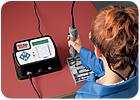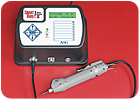
ASG provided Star with controlled-torque DC screwdrivers and error- proofing torque controllers to ensure that incorrectly assembled products do not reach customers. Source: ASG Division of Jergens Inc.
Star Headlight and Lantern Co. Inc. (Avon, NY) has manufactured warning lights for the railroad and automotive industries for more than 119 years. As the company expanded into new product lines, increased customer expectations led to the re-examination of its threaded fastener assembly techniques.
Warning lightbars found on police, fire and EMS vehicles were a relatively new addition to Star’s product offerings. When customers began to complain that lightbars were arriving damaged, management quickly focused on assembly procedures. “Screws holding the lights to the main bar were coming loose,” says Andy Hornyak, purchasing manager for Star. “The bar is an aluminum extrusion and acts as a heat sink, so this was a serious issue.”

The Smart Torq controller allows up to eight pre-programmed torques for each driver. Source: ASG Division of Jergens Inc.
Getting a Handle on Torque
Star invited ASG Division of Jergens Inc. (ASG, Cleveland) to evaluate the situation. ASG found that the battery-operated screwdrivers that Star’s assemblers were using were at the heart of the problem. “The battery drivers were a hardware-store variety, and while they were adequate for other assembly, they did not provide the degree of torque control required for a precision product,” says Thomas Beckwith, national sales manager for ASG.Star had suspected this to be the case and asked ASG about torque-controlled tools. Because Star operates a quiet, air-conditioned manufacturing facility, air tools and the accompanying noise and oil exhaust were ruled out. “We couldn’t ask our people to put up with the noise,” says Hornyak. “We needed a tool that the assemblers would feel good about. Our feeling is that we will get a better quality product if the employees are enjoying the process as much as possible.”
ASG supplied BL-7000 Series DC brushless torque-controlled drivers, which are rated for continuous use with minimal heat build-up in high production environments. The drivers automatically stop when a pre-set torque is reached to eliminate over or under tightening. ASG also recommended employing Smart Torq II controllers for the driver to help provide a greater level of control, but budget constraints precluded the purchase at that time.
Each BL-7000 screwdriver employed by Star can be adjusted to provide between 5 and 30 inch-pounds (lbf-in) of torque. Assembling a typical lightbar meant that an operator needed to change torque settings eight times as he moved from assembling one subcomponent to another. This constant adjustment proved to be too much. “Changing these torques by hand just was not working,” says Mike Datz, an engineer at Star. “Even with these great new drivers, operator variations were giving us unacceptable torque consistency.”
ASG was re-invited to evaluate, and together with Star, crafted a combination of training and hardware to solve the problem. Purchasing eight drivers for each assembler, one for each required torque, was out of the question.
Improving the Solution
To solve the problem, an ASG Smart Torq II controller/error-proofer was purchased for each assembler’s driver. The Smart Torq controller can eliminate most common fastener assembly mistakes. After it has “learned” the current draw vs. installation time characteristics of a representative fastener, it monitors the installation of all subsequent fasteners to ensure correct assembly. This is necessary because variations in hole size and thread quality can vary the friction encountered by a fastener as it is driven.“The single most common misconception in fastener torque control is that applied torque is directly linked to clamping force,” says ASG’s Beckwith. “The most accurate torque control drivers in the world-by themselves-still are not able to absolutely control fastener clamping force. You need a more sophisticated controller.”
Until recently, providing this level of precision was expensive, requiring torque transducers and angle encoders. The introduction of electrical current vs. time error-proofers has reduced costs by 300% to 400%, making the technology affordable for more organizations.
In addition to controlling torque output, the Smart Torq controller allows up to eight pre-programmed torques for each driver. Star’s assemblers now select from a clearly labeled panel to choose the torque for each subassembly. Because the Smart Torq device has learned the correct assembly sequence, if an error occurs the operator is immediately notified.
“The Smart Torq controller has eliminated the need for purchasing and maintaining multiple screwdrivers, reduced the time our operators spend on setup and torque changes, and, of course, helped ensure that all fasteners are correctly installed,” says Datz.
- ASG Division of Jergens Inc. (ASG)
(888) 486-6163
www.asg-jergens.com